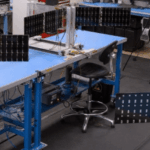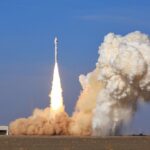Now Reading: Orion Capsule Heat Shield Damage Highlights Risks Ahead of Artemis II Mission
-
01
Orion Capsule Heat Shield Damage Highlights Risks Ahead of Artemis II Mission
Orion Capsule Heat Shield Damage Highlights Risks Ahead of Artemis II Mission


In December 2022, the Orion capsule celebrated its return from the monumental Artemis I mission, a journey that pushed boundaries beyond low Earth orbit. However, the mission’s conclusion did not come without complications, particularly concerning the capsule’s heat shield. While recovery personnel stood by, prepared to lift the capsule aboard the USS Portland, a hasty examination revealed visible cracks in the heat shield – a critical component designed to endure extreme conditions during reentry.
The reentry phase saw Orion plunging through the Earth’s atmosphere at astonishing speeds, ultimately leading to temperatures soaring as high as 5,000 degrees Fahrenheit (2,760 degrees Celsius). To effectively manage this thermal stress, the heat shield was engineered to withstand intense friction and absorb energy through a sacrificial process. Yet, the unexpected damage during the Artemis I mission raised pertinent questions about the engineering assumptions and material properties employed in the capsule’s heat shield design.
The heart of the heat shield’s functionality lies in its composite material, which includes a resin known as Novolac, arranged in a honeycomb structure of fiberglass threads. This design, akin to the legendary Apollo program, had previously demonstrated reliable performance. However, the complexities of reentry trajectories led to an overestimation of heat flow conditions, resulting in unforeseen thermal stresses that the material could not adequately handle. As the capsule encountered the atmosphere, the resin melted and generated gas, which eventually led to the formation of cracks as pressure built up.
- The Artemis I mission highlighted the necessity of rigorous testing and validation for spacecraft materials. This experience has been essential for NASA’s approach towards future missions.
- Incorporating advanced manufacturing methods for Artemis II aimed to improve the permeability of the heat shield, thereby reducing heat accumulation during the perilous reentry phase.
- Engineers and scientists recognized that adopting a modified trajectory for Artemis II would further mitigate the risk of heat stress by controlling the rate of descent and the dynamics involved during reentry.
NASA’s commitment to ensuring crew safety in future missions remains unwavering. With Artemis II and III on the horizon, the dialogue around the heat shield’s integrity is not merely a technical concern but an important aspect of astronaut safety. Engineers continue to analyze data and refine designs, emphasizing the importance of iterative learning in aerospace technology development.
The road ahead for Artemis III includes new strategies for shielding the capsule from extreme temperatures. As mission objectives evolve towards landing humans on the Moon by 2026, NASA must prioritize innovations that respect the unique challenges of space travel.
As we forge deeper into the cosmos, the damage observed on the Orion capsule serves as a potent reminder that every mission carries with it a wealth of knowledge and a foundation for the future. As aerospace professionals and enthusiasts, we must advocate for a culture of learning from both successes and failures. Each data point extracted from these missions enhances our capabilities and prepares us for the human exploration of distant worlds.
Stay Informed With the Latest & Most Important News
Previous Post
Next Post
-
 012024 in Review: Highlights from NASA in Silicon Valley
012024 in Review: Highlights from NASA in Silicon Valley -
 02Panasonic Leica Summilux DG 15mm f/1.7 ASPH review
02Panasonic Leica Summilux DG 15mm f/1.7 ASPH review -
 03From Polymerization-Enabled Folding and Assembly to Chemical Evolution: Key Processes for Emergence of Functional Polymers in the Origin of Life
03From Polymerization-Enabled Folding and Assembly to Chemical Evolution: Key Processes for Emergence of Functional Polymers in the Origin of Life -
 04How New NASA, India Earth Satellite NISAR Will See Earth
04How New NASA, India Earth Satellite NISAR Will See Earth -
 05And Thus Begins A New Year For Life On Earth
05And Thus Begins A New Year For Life On Earth -
 06Astronomy Activation Ambassadors: A New Era
06Astronomy Activation Ambassadors: A New Era -
07SpaceX launch surge helps set new global launch record in 2024




















